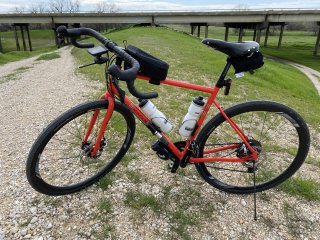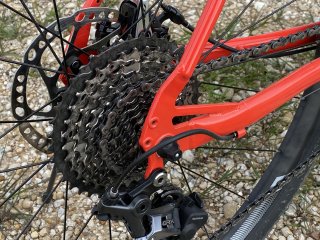A couple of weekends ago, I took a trip down to the Trinity Levee here in Dallas for my first big gravel ride of the year. This also turned out to be the first time trying out the new 11-40T cassette I installed on my 700c gravel wheelset.
I talked about overloading a Shimano GRX rear derailleur in a post late last year. To sum it up, the max that Shimano claims for the GRX RX810 rear derailleur is a 34T cassette. However, as others have learned, you can actually go a bit higher. In fact, you can run with a 40T cassette (with a few caveats though). I posted a video from Gravel Cyclist about this but, heck, here it is again:
So, I installed a Shimano XT M8000 cassette, tuned up the rear derailleur with it, and tossed the wheelset back on the racks. It was November when I installed it and I just never got around to getting a good gravel ride in to test it.
Now that it's March and quite a bit warmer, I got out onto the Trinity Levee to give the 40T cassette a whirl.
Most of the gravel on the Trinity Levee is pretty flat. It's not hilly at all. However, there are a number of areas where you have to go up the levee and back down again, most of which are pure gravel. Many of these inclines/declines are pretty steep with some rough gravel. As such, they're perfect for testing out different gravel tires as well as gear ratios for climbing.

I went down into the "valley" near the Trinity river and back up a few times during my ride. The couple of times I went back up, I made sure to use the lowest gear to get a feel for the new 40T cog. Definitely could tell a difference. Climbing was a bit easier for sure compared to a 34T cog.
Now, to get some perspective, we have to think about the gear ratios a bit.
When I first started riding gravel, I was using the stock 50/34T crankset with an 8-speed 11-32T cassette that came on my bike. In the lowest gear, that equated to a 1.06 gear ratio. That's a bit higher than a 1-to-1 gear ratio. I could make the climbs but, man, were my legs super freaking tired! Those short burst of power were draining at best.
When I upgraded to the GRX groupset, I ended up with a 48/31T crankset and a 11-speed 11-34T cassette. My lowest gear now ended up having a 0.91 gear ratio. Now I'm under a 1-to-1 ratio. Those same climbs were easier for sure. Definitely an improvement.
However, what I found was that, while short climbs were ok, sustained climbs were quite brutal. So when I learned that I could overload the rear derailleur I jumped right on it. Going from a 34T to a 40T cog results in a 0.78 ratio. Doesn't sound like a lot but that's easily a 13% increase in climbing power for the same amount of effort, which is enough to help me immensely with sustained climbs.
Overall, I'm super pleased with the fact that I can throw a 40T cassette on my bike. That adds an incredible amount of flexibility to my rides. For harder gravel rides with lots of hills, I seriously doubt I'll go back to anything less that a 40T cassette. Bazinga!

Post a comment!
Comments
I have this set up on my Pivot Vault. What I’m finding is the last 2 gears “small” with front 31T sag a lot! I’m going to replace the 48 with a 46 big ring. I was running ultegra front crank with 46/34. My legs hurt a lot. I need more range for my 59 year old legs. We shall see.
I had a Domane SLR Ultegra Di2, and to cope with the steep (20%) climbs here, got a 11-40T 11sp cassette attached with a "road link" hanger extension. All OK for thousands of miles until the derailleur got into the wheel, hanger broke, carbon frame irreparably damaged. Bought a titanium frame and had the bike built up with the old components. After couple of hundred miles, the same happened. This time the derailleur went through between the spokes and was stuck inside the wheel. The derailleur broke apart, no hanger extension needed with this frame. I've got no clue why it happened. Is the 40T cog just too big for the Ultegra derailleur? Should I replace it with a GRX or Ultegra?
Will a GRX derailleur work? Maybe...and that's a big maybe. The only Di2 compatible GRX derailleurs are the RX815 and RX817. The RX815 is definitely a no-go due to the 34T max capacity (no way a 40T will work!). The RX817 has a max capacity of 42T...so no hacking to get it to work with a 40T. However, the problem is that it's really only compatible with a 1x setup. So, yeah, can't say with any certainty if it would work.
My guess as to why your Ultregra derailleurs failed is because of the extra stress being added. The stress of running a large cassette really only works if the derailleur was designed to handle it. A LOT of stress happens between the cassette and that top cog of the derailleur. A larger cassette creates a much smaller gap with the chain running really close between them. The GRX line is really a hybrid of both road and mountain bike tech, which means beefier hangers and a clutch. Most standard road bike derailleurs don't have a clutch and generally don't have beefy hangers like mountain bikes do. Even with a hanger extension, while it does add more room, it still doesn't take away the stress added to the drivetrain. That's probably the best explanation on why it eventually failed.
If you want more climbing ability, you might be better off switching to a 1x GRX setup with a RX817. You'll loose some of the top-end gearing...but still have all that low-end for climbing. Upside is that if your bike can handle it you could throw on wider tires and transform it into a gravel bike. Just hard to have both really. On my road bike, I run a 105 groupset and used the largest 105 rear derailleur I could get. With 34T's in the front and back, that gives me a little under a 1-to-1 gear ratio when in the lowest gear. It's not great...but it works. :D
Did you have the medium or the short cage di2 derailleur ? I've had the same setup and done 10s of thousands of klm. 1. You need the medium cage di2 jobby or a grx. 2. You need to ensure you have the correct length chain and its not worn (stretched). Too short and you're putting too much strain on the deraileur in some gears. Check this with big to big. If your derailleur is pulled out 'flat' you've got a problem. Same thing can happen with gunked up chain as its adding too much drag. You'll like end up needing a chain that is quite long and flaps around abit on the rough stuff and this can also cause the chain to jump around into the jockey wheel and eventually cause catastrophic damage, suck up the chain and tear off the deraileur. You have to get the length just right but I'd go longer rather than shorter. Even better goto SRAM, they have far better wide range gearing now. Shimano missed an opportunity with GRX.
Hey Jeff, just wanted to check when you upgraded the cassette, was this using the Marin Hubs that came with the Nicasio? I have a Nicasio 2 at the moment that I am thinking of trying the 11-40 on but am unsure if the 11 speed cassette will fit?
Good question. To be honest, I replaced the wheels and hubs on my Nicasio. It was one of the things I did early on. I found the stock hubs to be quite finicky so I was pretty quick early on to upgrade them. Glad I did though. Updated hubs are much easier to work with and allow me to put whatever cassette I want on them with relative ease.
That said, it might be possible to put an 11-speed cassette on the stock hubs. However, I can't say with any certainty that the hub will allow for one. If it's a 10-speed cassette that's already on there, shouldn't be a problem. But if it's an 8- or 9-speed cassette...yeah...that might not work.